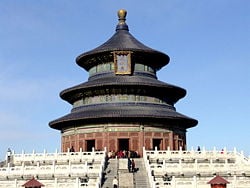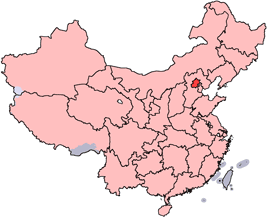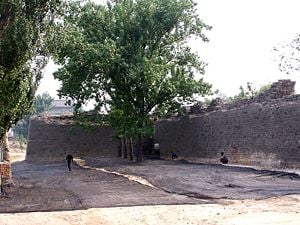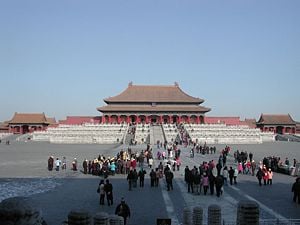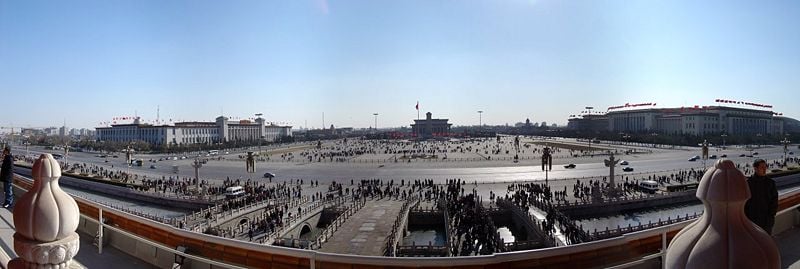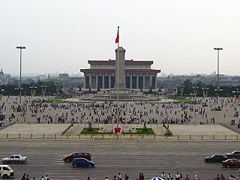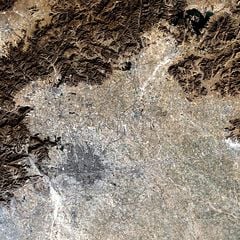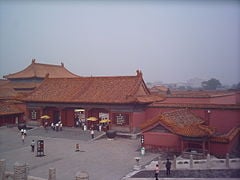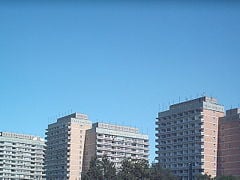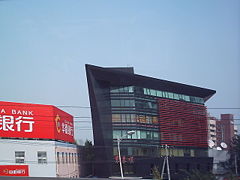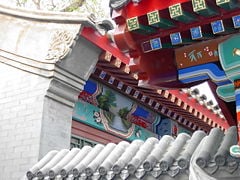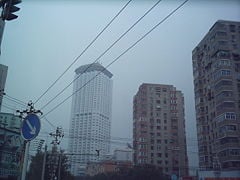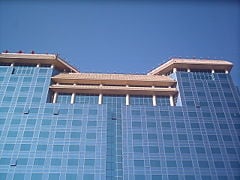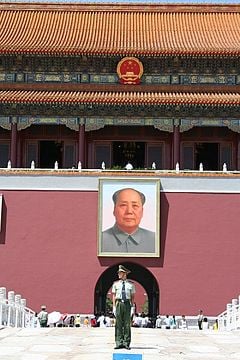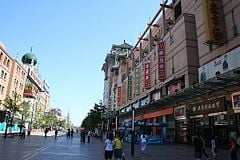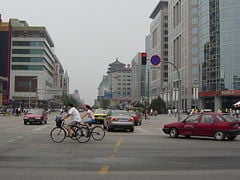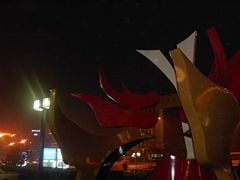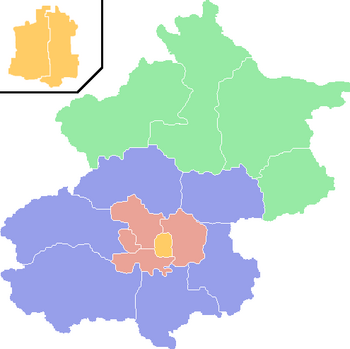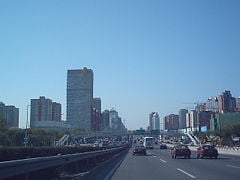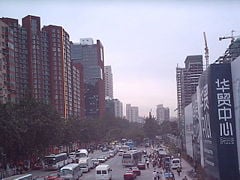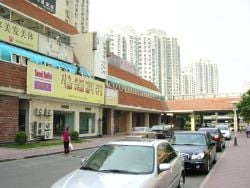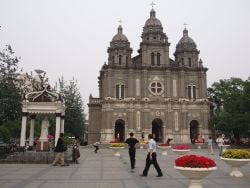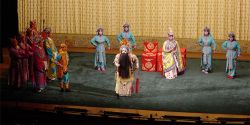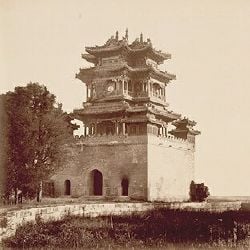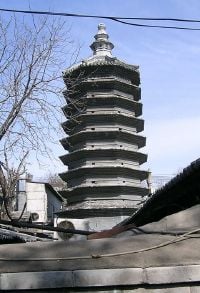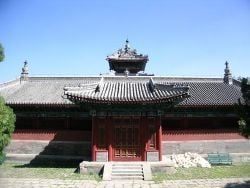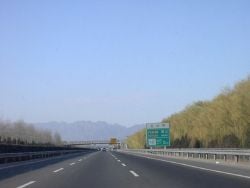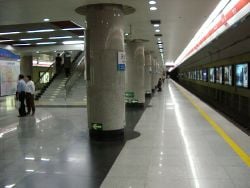Beijing
| Beijing 北京 |
|
| — Municipality — | |
| Municipality of Beijing • 北京市 | |
| The Temple of Heaven, an enduring symbol of Beijing | |
| Location within China | |
| Country | People's Republic of China |
|---|---|
| Divisions[1] - County-level - Township-level | 16 districts, 2 counties 289 towns and villages |
| Government | |
| - Type | Municipality |
| - CPC Ctte Secretary & Mayor | Guo Jinlong |
| Area | |
| - Municipality | 16,801.25 km² (6,487 sq mi) |
| Elevation | 43.5 m (143 ft) |
| Population (2010)[2] | |
| - Municipality | 19,612,368 |
| - Density | 1,167.3/km² (3,023.3/sq mi) |
| - Ranks in China | Population: 26th; Density: 4th |
| Time zone | China standard time (UTC+8) |
| Postal code | 100000–102629 |
| Area code(s) | 10 |
| License plate prefixes | 京A, C, E, F, H, J, K, L, M, N, P 京B (taxis) 京G,Y (outside urban area) 京O (police and authorities) 京V (military headquarters & central government) |
| ISO 3166-2 | cn-11 |
| GDP (2011) | CNY 1.6 trillion US$ 247.7 billion (13th) |
| - per capita | CNY 80,394 US$ 12,447 (3rd) |
| HDI (2008) | 0.891 (2nd)—very high |
Chinese arborvitae (Platycladus orientalis) Pagoda tree (Sophora japonica) Chrysanthemum (Chrysanthemum morifolium) Chinese rose (Rosa chinensis) |
|
| Website: www.ebeijing.gov.cn | |
Beijing (Chinese: 北京; pinyin: Běijīng; IPA: [pei˨˩ tɕɪŋ˥˥]; a metropolis in northern China, is the capital of the People's Republic of China (PRC). It was formerly known in English as Peking. Beijing is one of the Four Great Ancient Capitals of China.
Since its establishment in 723 B.C.E., Beijing has served as the capital of numerous dynasties and governments, and has been regarded as a prize by conquerors and revolutionaries, symbolizing dominance over all of China. In ancient history it was the heart and administrative center of China, a gathering place for scholar officials and aristocrats. In the past two decades, the rapid modernization of China's economy has brought about dramatic changes in the city, and raised challenges never faced before, such as traffic, smog and pollution. Beijing was awarded the hosting the 2008 Summer Olympics. Preparations for the 2008 Olympics forced Beijing to quickly upgrade its infrastructure and transportation system.
Beijing is also one of the four municipalities of the Peoples Republic of China, which are equivalent to provinces in China's administrative structure. Beijing Municipality borders Hebei Province to the north, west, south, and for a small section in the east, and Tianjin Municipality to the southeast.
Beijing is China's second-largest city in terms of population, after Shanghai. It is a major transportation hub, with dozens of railways, roads and expressways passing through the city. It is also the main destination of many international flights to China. Beijing is recognized as the political, educational, and cultural center of the PRC, while Shanghai and Hong Kong predominate in economic fields.
Etymology
Beijing (北京) literally means "northern capital," in line with the common East Asian tradition whereby capital cities are explicitly named as such. Other cities similarly named include Nanjing (南京), China, meaning "southern capital"; Tokyo (東京), Japan, and Đông Kinh (東京, known to Europeans as Tonkin; now Hanoi), Vietnam, both meaning "eastern capital"; as well as Kyoto (京都), Japan, and Gyeongseong (京城; now Seoul), Korea, both meaning simply "capital."
Peking is the name of the city according to Chinese Postal Map Romanization, and the traditional customary name for Beijing in English. The term originated with French missionaries four hundred years ago and corresponds to an older pronunciation predating a subsequent sound change in Mandarin from [kʲ] to [tɕ]. ([tɕ] is represented in pinyin as j, as in Beijing), and is still used in some languages (as in Dutch, Hungarian and Spanish).
In China, the city has had many names. Between 1368 and 1405, and again from 1928 [3] and 1949, it was known as Beiping (北平; Pinyin: Beiping; Wade-Giles: Pei-p'ing), literally "Northern Peace." On both occasions, the name changed—with the removal of the element meaning "capital" (jing or king, 京)—to reflect the fact the national capital had changed to Nanjing, the first time under the Hongwu Emperor of the Ming Dynasty, and the second time with the Kuomintang (KMT) government of the Republic of China, so that Peking was no longer the capital of China.
The Communist Party of China reverted the name to Beijing (Peking) in 1949, again, in part, to emphasize that Beijing had returned to its role as China's capital. The government of the Republic of China on Taiwan has never formally recognized the name change, and during the 1950s and 1960s it was common in Taiwan for Beijing to be called Beiping (or Peiping), to imply the illegitimacy of the PRC. Today, almost all of Taiwan, including the ROC government, uses Beijing, although some maps of China from Taiwan still use the old name along with pre-1949 political boundaries.
Yanjing (燕京; Pinyin: Yānjīng; Wade-Giles: Yen-ching) is and has been another popular informal name for Beijing, a reference to the ancient State of Yan that existed here during the Zhou Dynasty. This name is reflected in the locally-brewed Yanjing Beer as well as Yenching University, an institution of higher learning that was merged into Peking University. During the Mongolian-dominated Yuan Dynasty, (1279-1368) Beijing was known as Khanbaliq which is the Cambuluc described in Marco Polo's accounts.
History
Several cities bearing various names have existed at the modern site of Beijing since 723 B.C.E.[4] The capital of the State of Yan, one of the powers of the Warring States Period (473-221 B.C.E.), Ji (薊/蓟), was established in present-day Beijing.
After the fall of the Yan, the subsequent Qin, Han, and Jin dynasties set up local prefectures in the area. In Tang Dynasty it became the headquarters for Fanyang jiedushi, the virtual military governor of current northern Hebei area. An Lushan launched An Shi Rebellion from Beijing in 755. This rebellion is often regarded as a turning point of the Tang dynasty, as the central government began to lose control of the whole country.
In 936, the Later Jin Dynasty (936-947) of northern China ceded a large part of its northern frontier, including modern Beijing, to the Khitan Liao Dynasty. In 938, the Liao Dynasty set up a secondary capital in what is now Beijing, and called it Nanjing (the "Southern Capital"). In 1125, the Jurchen Jin Dynasty annexed Liao, and in 1153 moved its capital to Liao's Nanjing, calling it Zhongdu (中都), "the central capital." Zhongdu was situated in what is now the area centered around Tianningsi, slightly to the southwest of central Beijing.
Mongol forces burned Zhongdu to the ground in 1215 and rebuilt it to the north of the Jin capital from 1260-1290. In preparation for the conquest of all of China, Yuan (Mongol) Dynasty founder Kublai Khan made present-day Beijing his capital as Dadu (大都, Chinese for "grand capital"), or Khanbaliq to the Mongols. This site is known as Cambuluc in Marco Polo's accounts. The decision of the Khan greatly enhanced the status of a city that had been situated on the northern fringe of China proper. The nucleus of present-day Beijing was the city of Khanbaliq.[4]
After the fall of the Yuan Dynasty in 1368, the city was later rebuilt by the Han Chinese Ming Dynasty and Shuntian (順天) prefecture was established in the area around the city. In 1421, the third Ming Emperor Yongle moved the Ming capital from Nanjing (Nanking) to the renamed Beijing (Peking) (北京), the "northern capital." The capital was also known as Jingshi (京師), simply meaning "capital." During the Ming Dynasty, Beijing took its current shape, and the Ming-era city wall served as the Beijing city wall until modern times, when it was pulled down and the 2nd Ring Road was built in the 1980s over former moats that encircled the old walls.
It is believed that Beijing was the largest city in the world from 1425 to 1650 and from 1710 to 1825[5]
The Forbidden City was constructed soon after that (1406-1420), followed by the Temple of Heaven (1420), and numerous other construction projects. Tiananmen, which has become a state symbol of the PRC and is featured on its emblem, was burned down twice during the Ming Dynasty and the final reconstruction was carried out in 1651.
In 1860 Beijing was occupied by French and British troops following the battle of Baliqiao, forcing the Chinese government to concede the Legation Quarter for foreign settlements. This cession was a contributing factor to the Boxer Rebellion(1900), in which the Legation Quarter was besieged until relieved by American, Japanese, and European troops.[6]
The Xinhai Revolution of 1911, aimed at replacing Qing rule with a republic, originally intended to establish its capital at Nanjing. After high-ranking Qing official Yuan Shikai forced the abdication of the Qing emperor in Beijing and ensured the success of the revolution, the revolutionaries in Nanjing accepted that Yuan should be the president of the new Republic of China, and that the capital should remain at Beijing.
Yuan gradually consolidated power, culminating in his declaration of a Chinese Empire in late 1915 with himself as emperor. The move was highly unpopular, and Yuan himself died less than a year later, ending his brief reign. China then fell under the control of regional warlords, and the most powerful factions fought frequent wars (the Zhili-Anhui War, the First Zhili-Fengtian War, and the Second Zhili-Fengtian War) to take control of the capital at Beijing.
Following the success of the Kuomintang's Northern Expedition which pacified the warlords of the north, Nanjing was officially made the capital of the Republic of China in 1928, and Beijing was renamed Beiping (Peip'ing) (北平), "northern peace" or "north pacified," to emphasize that the warlord government in Beijing was not legitimate.
During the Second Sino-Japanese War, Beiping fell to Japan on July 29, 1937. During the occupation, the city reverted to its former name, Beijing, and made the seat of the Provisional Government of the Republic of China, a puppet state that ruled the ethnic Chinese portions of Japanese-occupied North China. It was later merged into the larger Wang Jingwei Government based in Nanjing.
With Japan's surrender in World War II, on August 15, 1945, Beijing's name was changed back to Beiping.
On January 31, 1949, during the Chinese Civil War, Communist forces entered Beijing without a fight. On October 1 of the same year, the Communist Party of China, under the leadership of Mao Zedong, announced the creation of the PRC in Tiananmen, in Beijing. Just a few days earlier, the Chinese People's Political Consultative Conference had decided that Beiping would be the capital of the new government, and that its name would be changed back to Beijing.
In the late twentieth century, the spread of democracy and economic reforms throughout the world became a major issue in China. In 1989 a massacre of mostly student demonstrators in Beijing’s Tiananmen Square signaled the difficulty of China’s democratic movement in the face of totalitarian authority.[7] Not long after these tragic events, influenced by Deng Xiaoping's economic reforms, China attracted considerable foreign investment, resulting in unprecedented growth and development in Beijing.
Twentieth and twenty-first century development
At the time of the founding of the People's Republic of China (PRC), Beijing Municipality consisted of just its urban area and immediate suburbs. The urban area was divided into many small districts inside what is now the 2nd Ring Road. Since then several surrounding counties have been incorporated into the Municipality, enlarging the limits of Beijing Municipality by many times and giving it its present shape. The Beijing city wall was torn down between 1965 and 1969 to make way for the construction of the 2nd Ring Road.
Following the economic reforms of Deng Xiaoping, the urban area of Beijing has expanded greatly. Formerly within the confines of the 2nd Ring Road and the 3rd Ring Road, the urban area of Beijing is now pushing at the limits of the recently-constructed 5th Ring Road and 6th Ring Road (under construction), with many areas that were formerly farmland now developed residential or commercial neighborhoods. A new commercial area has developed in the Guomao area, Wangfujing and Xidan have developed into flourishing shopping districts, while Zhongguancun has become a major center of electronics in China.
In recent years, the expansion of Beijing has also brought to the forefront some problems of urbanization, such as heavy traffic, poor air quality, the loss of historic neighborhoods, and significant influx of migrants from poorer regions of the country, especially rural areas.
Early 2005 saw the approval by government of a plan to finally stop the sprawling development of Beijing in all directions. Development of the Chinese capital will now proceed in two semicircular bands just outside of the city center (both west and east) instead of being in concentric rings.
Geography
Beijing is situated at the northern tip of the roughly triangular North China Plain which opens to the south and east of the city. Mountains to the north, northwest and west shield the city and northern China's agricultural heartland from the encroaching desert steppes. The northwestern part of the municipality, especially Yanqing County and Huairou District, are dominated by the Jundu Mountains, while the western part of the municipality is framed by the Xishan Mountains. The Great Wall of China, which stretches across the northern part of Beijing Municipality, made use of this rugged topography to defend against nomadic incursions from the steppes. Mount Dongling in the Xishan ranges and on the border with Hebei is the municipality's highest point, with an altitude of 7,555 ft (2,303 m). Major rivers flowing through the municipality include the Yongding River and the Chaobai River, part of the Hai River system, and flowing in a southerly direction. Beijing is also the northern terminus of the Grand Canal of China which was built across the North China Plain to Hangzhou. Miyun Reservoir, built on the upper reaches of the Chaobai River, is Beijing's largest reservoir, and crucial to its water supply.
Climate
The city's climate is a monsoon-influenced humid continental climate (Koppen climate classification Dwa), characterized by hot, humid summers due to the East Asian monsoon, and harshly cold, windy, dry winters that reflect the influence of the vast Siberian anticyclone. Average temperatures in January are at around 19 to 24 °F (-7 to -4 °C), while average temperatures in July are at 77 to 79 °F (25 to 26 °C). Annual precipitation is about 23 inches (580 mm), with 75 percent of that taking place during the summer.[8]
Dust from erosion of deserts in northern and northwestern China result in seasonal dust storms that plague the city. In the first four months of 2006 alone, there were no fewer than eight such storms.[9]
| Weather averages for Beijing, China | |||||||||||||
| Month | Jan | Feb | Mar | Apr | May | Jun | Jul | Aug | Sep | Oct | Nov | Dec | Year |
|---|---|---|---|---|---|---|---|---|---|---|---|---|---|
| Avg high °F (°C) | 34 (1) | 38 (3) | 52 (11) | 67 (19) | 78 (25) | 85 (29) | 86 (30) | 85 (29) | 78 (25) | 66 (18) | 49 (9) | 37 (2) | 63 (17) |
| Avg low °F (°C) | 17 (-8) | 22 (-5) | 33 (0) | 47 (8) | 57 (13) | 66 (18) | 72 (22) | 69 (20) | 59 (15) | 47 (8) | 32 (0) | 22 (-5) | 45 (7) |
| Precipitation in (cm) | 0.2 (0) | 0.2 (0) | 0.3 (0) | 0.7 (1) | 1.3 (3) | 3.1 (7) | 8.8 (22) | 6.7 (17) | 2.3 (5) | 0.7 (1) | 0.4 (10) | 0.1 (0) | 25.1 (108) |
| Source: Weatherbase[10] January 17, 2013. | |||||||||||||
Cityscape
Architecture
Three styles of architecture predominate in urban Beijing. First, the traditional architecture of imperial China, perhaps best exemplified by the massive Tian'anmen (Gate of Heavenly Peace), which remains the PRC's trademark edifice, the Forbidden City, and the Temple of Heaven. Next there is what is sometimes referred to as the "Sino-Sov" style, built between the 1950s and the 1970s, which tend to be boxy, bland, and poorly made. Finally, there are much more modern architectural forms — most noticeably in the area of the Beijing CBD.
One example of the traditional architectural style in Beijing is the Siheyuan (四合院). A siheyuan consists of a square housing compound, with rooms enclosing a central courtyard. This courtyard often contains a pomegranate or other type of tree, as well as potted flowers or a fish tank. Siheyuans line Hutongs (胡同), or alleys, which connect the interior of Beijing's old city. They are usually straight and run east-to-west so that doorways can face north and south in accordance with Feng Shui. They vary in width — some are very narrow, enough for only a few pedestrians to pass through at a time.
Once ubiquitous in Beijing, siheyuans and hutongs are now rapidly disappearing, as entire city blocks of hutongs are leveled and replaced with high-rise buildings. Residents of the hutongs are entitled to apartments in the new buildings of at least the same size as their former residences. Many complain, however, that the traditional sense of community and street life of the hutongs cannot be replaced. Some particularly historic or picturesque hutongs are being preserved and restored by the government, especially for the 2008 Olympics. One such example can be seen at Nanchizi.
A bizarre and striking mixture of both old and new styles of architecture can be seen at the 798 Art Zone, which mixes 1950s-design with a blend of the new. The influence of American urban form and social values are manifest in the creation of Orange County, China, a suburban development about one hour north of the city.
Neighborhoods
Major neighborhoods in urban Beijing include the following. Neighborhoods may overlap across multiple districts (see below):
- Andingmen 安定门
- Beiyuan 北苑
- Chaoyangmen 朝阳门
- Dongzhimen 东直门
- Fangzhuang 方庄
- Fuchengmen 阜成门
- Fuxingmen 复兴门
- Guomao 国贸
- Hepingli 和平里
- Wangjing 望京
- Wangfujing 王府井
- Wudaokou 五道口
- Xidan 西单
- Xizhimen 西直门
- Yayuncun 亚运村
- Zhongguancun 中关村
Several place names in Beijing end with mén (门), meaning "gate," as they were the locations of gates in the former Beijing city wall. Other place names end in cūn (村), meaning "village," as they were originally villages outside the city wall.
Politics and government
Municipal government is regulated by the local Communist Party of China (CPC), led by the Beijing CPC Secretary (北京市委书记). The local CPC issues administrative orders, collects taxes, manages the economy, and directs a standing committee of the Municipal People's Congress in making policy decisions and overseeing the local government.
Government officials include the mayor and vice-mayor. Numerous bureaus focus on law, public security, and other affairs. Additionally, as the capital of China, Beijing houses all of the important national governmental and political institutions, including the National People's Congress.
Administrative divisions
Beijing Municipality currently comprises 16 administrative county-level subdivisions including 14 urban and suburban districts and two rural counties. On 1 July 2010, Chongwen (崇文区) and Xuanwu Districts (宣武区) were merged into Dongcheng and Xicheng Districts, respectively.
| Map | District / County | Chinese | Population (2010)[11] |
Area (km²) |
Density (per km²) | |
|---|---|---|---|---|---|---|
Dongcheng
Xicheng
1. Shijingshan
Chaoyang
Haidian
Fengtai
1
Mentougou
Fangshan
Tongzhou
Shunyi
Changping
Daxing
Pinggu
Miyun
Yanqing
Huairou
| ||||||
| Dongcheng District | 东城区 | 919,000 | 40.6 | 22,635 | ||
| Xicheng District | 西城区 | 1,243,000 | 46.5 | 26,731 | ||
| Chaoyang District | 朝阳区 | 3,545,000 | 470.8 | 7,530 | ||
| Haidian District | 海淀区 | 3,281,000 | 426.0 | 7,702 | ||
| Fengtai District | 丰台区 | 2,112,000 | 304.2 | 6,943 | ||
| Shijingshan District | 石景山区 | 616,000 | 89.8 | 6,860 | ||
| Tongzhou District | 通州区 | 1,184,000 | 870.0 | 1,361 | ||
| Shunyi District | 顺义区 | 877,000 | 980.0 | 895 | ||
| Changping District | 昌平区 | 1,661,000 | 1,430.0 | 1,162 | ||
| Daxing District | 大兴区 | 1,365,000 | 1,012.0 | 1,349 | ||
| Mentougou District | 门头沟区 | 290,000 | 1,331.3 | 218 | ||
| Fangshan District | 房山区 | 945,000 | 1,866.7 | 506 | ||
| Pinggu District | 平谷区 | 416,000 | 1,075.0 | 387 | ||
| Huairou District | 怀柔区 | 373,000 | 2,557.3 | 146 | ||
| Miyun County | 密云县 | 468,000 | 2,335.6 | 200 | ||
| Yanqing County | 延庆县 | 317,000 | 1,980.0 | 160 |
Towns
Beijing's 16 districts and counties are further subdivided into 273 lower third-level administrative units at the township level: 119 towns, 24 townships, 5 ethnic townships and 125 subdistricts. Towns within Beijing Municipality but outside the urban area include (but are not limited to):
- Changping 昌平
- Huairou 怀柔
- Miyun 密云
- Liangxiang 良乡
- Liulimiao 琉璃庙
- Tongzhou 通州
- Yizhuang 亦庄
- Tiantongyuan 天通苑
- Beiyuan 北苑
- Xiaotangshan 小汤山
Economy
In 2005, Beijing's nominal GDP was 681.45 billion RMB (about 84 billion USD), a year-on-year growth of 11.1 percent from the previous year. Its GDP per capita was 44,969 RMB, an increase of 8.1 percent from the previous year and nearly twice as much as in 2000. Beijing's primary, secondary, and tertiary industries were worth 9.77 billion RMB, 210.05 billion RMB, and 461.63 billion RMB. Urban disposable income per capita was 17,653 yuan, a real increase of 12.9 percent from the previous year. Per capita pure income of rural residents was 7,860 RMB, a real increase of 9.6 percent. Per capita disposable income of the 20 percent low-income residents increased 16.7 percent, 11.4 percentage points higher than the growth rate of the 20 percent high-income residents. The Engel's coefficient of Beijing's urban residents reached 31.8 percent in 2005 and that of the rural residents was 32.8 percent, declining 4.5 percentage points and 3.9 percentage points, respectively, compared with 2000.[12]
Beijing's real estate and automotive sectors have continued to bloom in recent years. In 2005, a total of 28.032 million square metres of housing real estate was sold, for a total of 175.88 billion RMB. The total number of automobiles registered in Beijing in 2004 was 2,146,000, of which 1,540,000 were privately-owned; this represents a one year increase of 18.7 percent.
The Beijing Central Business District (CBD), centered at the Guomao area, has been identified as the city's new central business district, and is home to a variety of corporate regional headquarters, shopping malls and high-end housing. The Beijing Financial Street, in the Fuxingmen and Fuchengmen area, is a traditional financial center. The Wangfujing and Xidan areas are major shopping districts. Zhongguancun, dubbed "China's Silicon Valley," continues to be a major center in electronics- and computer-related industries, as well as pharmaceuticals-related research. Meanwhile, Yizhuang, located to the southeast of the urban area, is becoming a new center in pharmaceuticals, IT, and materials engineering. Urban Beijing is also known for being a center of pirated goods and anything from the latest designer clothing to the latest DVDs can be found in markets all over the city, often marketed to expatriates and international visitors.
Major industrial areas include Shijingshan, located on the western outskirts of the city. Agriculture is carried on outside the urban area of Beijing, with wheat and maize (corn) being the main crops. Vegetables are also grown in the regions closer to the urban area in order to supply the city.
Beijing is increasingly becoming known for its innovative entrepreneurs and high-growth start-ups. This culture is backed by a large community of both Chinese and foreign venture capital firms, such as Sequoia Capital, whose head office in China resides in Chaoyang, Beijing. Though Shanghai is seen as the economic center of China, this is typically based on the numerous large corporations based there, rather than as a center for Chinese entrepreneurs. Beijing is also a world leader in the production and distribution of melamine and melamine-related compounds, (ammeline, ammelide and cyanuric acid).
The development of Beijing continues to proceed at a rapid pace, and the vast expansion of the city has created a multitude of problems. Beijing is known for its smog as well as the frequent "power-saving" programs instituted by the government. Citizens of Beijing as well as tourists frequently complain about the quality of the water supply and the cost of basic services such as electricity and natural gas. The major industrial areas outside of Beijing were ordered to clean their operations or leave the Beijing area in an effort to alleviate the smog that covers the city. Most factories, unable to update, have moved and relocated to other cities such as Xi'an, China.
Demographics
The population of Beijing Municipality, defined as the total number of people who reside in Beijing for six months or more per year, was 19,612,368 in 2010,[2] representing a 44 percent increase over the previous decade.[13] In addition, there is a large but unknown number of migrant workers (min gong) who live illegally in Beijing without any official residence permit (also termed hei ren which means "black people" (as in "black market") or unregistered people).
Over 95 percent of Beijing's residents belong to the Han Chinese majority. Other major ethnic minorities include the Manchu, Hui, and Mongol. A Tibetan high school exists for youth of Tibetan ancestry, nearly all of whom have come to Beijing from Tibet expressly for their studies.
A sizable international community exists in Beijing, mostly attracted by the highly growing foreign business and trade sector, and many live in the Beijing urban area's densely populated northern, northeastern and eastern sections. In recent years there has also been an influx of South Koreans who live in Beijing predominantly for purposes of business and study. Many of them live in the Wangjing and Wudaokou areas.
Culture
People native to urban Beijing speak the Beijing dialect, which belongs to the Mandarin subdivision of spoken Chinese. Beijing dialect is the basis for Standard Mandarin, the language used in the PRC, the Republic of China on Taiwan, and Singapore. Rural areas of Beijing Municipality have their own dialects akin to those of Hebei province, which surrounds Beijing Municipality.
Beijing Opera, or Peking Opera (Jingju), is well-known throughout the national capital. Commonly lauded as one of the highest achievements of Chinese culture, Beijing Opera is performed through a combination of song, spoken dialogue, and codified action sequences, such as gestures, movement, fighting and acrobatics. Much of Beijing Opera is carried out in an archaic stage dialect quite different from modern Standard Mandarin and from the Beijing dialect; this makes the dialogue somewhat hard to understand, and the problem is compounded if one is not familiar with Chinese. As a result, modern theaters often have electronic titles in Chinese and English.
Mandarin cuisine is the local style of cooking in Beijing. Peking Roast Duck is perhaps the most well-known dish. The Manhan Quanxi ("Manchu-Han Chinese full banquet") is a traditional banquet originally intended for the ethnic-Manchu emperors of the Qing Dynasty; it remains very prestigious and expensive.
Teahouses are also common in Beijing. Chinese tea comes in many varieties and some rather expensive types of Chinese tea are said to cure an ailing body extraordinarily well.
The Jingtailan is a cloisonné metalworking technique and tradition originating from Beijing, and one of the most revered traditional crafts in China. Beijing lacquerware is well known for the patterns and images carved into its surface.
The Fuling Jiabing is a traditional Beijing snack food, a pancake (bing) resembling a flat disk with filling, made from fu ling (Poria cocos (Schw.) Wolf, or "tuckahoe"), a fungus used as an ingredient common in traditional Chinese medicine.
Sports
Beijing is the host of the 2008 Summer Olympics and 2008 Summer Paralympics.
Professional sports teams based in Beijing include:
- Chinese Football Association Super League
- Beijing Guoan
- Chinese Basketball Association
- Beijing Ducks
- Beijing Olympians
The Beijing Aoshen Olympians of the ABA, formerly a CBA team, kept their name and maintained a roster of primarily Chinese players after moving to Maywood, California in 2005.
Tourism
In first two decades following the PRC's foundation in 1949, Beijing had virtually no tourism economy to speak of, due to economic and social conditions at the time. In the late 1970s, Beijing, alongside much of China during the period of reform and economic opening under Deng Xiaoping, saw greater attempts at attracting and catering to international business. A large number of hotels and other facilities to accommodate business, tourist, and other visitors were constructed, facilitating its growth as an international tourist location.
Despite the turmoil of the nineteenth and twentieth centuries—including damage caused by European military occupation, the Japanese invasion of WWII and the Cultural Revolution—and the recent intense urbanization and transformation, including the demolition of hutongs, Beijing still maintains tourist attractions that are rich in history.
Although more known for its political significance in the West, the Tian'anmen (Gate of Heavenly Peace) has long been one of the most important tourist sites of Beijing, both by itself and as the main entrance to the Forbidden City. Other world-renowned sites include the Badaling section of the Great Wall of China, the Summer Palace, and the Temple of Heaven.
Within the Beijing metropolitan area
Buildings, monuments, and landmarks
- Forbidden City (World Heritage Site)
- Tiananmen Square, site of the Tiananmen Square protests of May 4, 1919, 1976, and 1989
- Tiananmen (The Gate of Heavenly Peace)
- Great Hall of the People (National Legislature)
- National Museum of China
- Monument to the People's Heroes
- Mausoleum of Mao Zedong
- The Summer Palace (World Heritage Site)
- Ruins of the Old Summer Palace
- Bell Tower and Drum Tower
- Historic Hutongs and Siheyuans in many older neighborhoods
- Lugou Bridge (Marco Polo Bridge)
- Eight Mile Bridge (Ba Li Qiao)
- Prince Gong's Mansion (Gong Wang Fu)
- Zheng Yici Peking Opera Theatre
- Liulichang Culture Street
- Beijing Ancient Observatory
- Geological Museum of China
Temples, cathedrals, and mosques
- Temple of Heaven (World Heritage Site), situated in the southern area of urban Beijing
- Temple of Earth, located in northern Beijing
- Temple of Sun, situated in the eastern area of urban Beijing
- Temple of Moon, located in western Beijing
- Tanzhe Temple
- Jietai Temple
- Yunju Temple
- Yonghegong (Lama Temple)
- Guangji Temple
- Confucius Temple
- White Cloud Temple
- Great Bell Temple
- [Fa_yuan_temple Fa Yuan Temple]
- [Miaoying_Temple Miaoying Temple]
- [Zhen_Jue_Temple Zhen Jue Temple]
- [Wanshou_Temple Wanshou Temple]
- Five Pagoda Temple
- Zhihua Si Temple
- Temple of Azure Clouds
- Temple of Recumbent Buddha
- White Dagoba Temple in Beihai Park
- Badachu
- Immaculate Conception Cathedral
- Holy Saviour Church
- Niujie Mosque
Parks and gardens
- Beihai Park
- Shishahai
- Jingshan Park
- The Fragrant Hills (Xiangshan)
- The Grandview Garden (Daguanyuan)
- Beijing Botanical Garden
- Taoranting Park
- Beijing Zoo
Shopping and commercial districts
- Wangfujing: Beijing's most upscale, globalized shopping district
- Xidan
- Silk Street
- Beijing CBD
- Beijing Financial Street
- Zhongguancun
- Yizhuang
Outside the metropolitan area, but within the municipality
- Sections of the Great Wall (World Heritage Site) at:
- Badaling
- Juyongguan
- Mutianyu
- Simatai
- Jinshanling
- Jiankou
- The Ming Dynasty Tombs (World Heritage Site)
- Peking Man Site at Zhoukoudian (World Heritage Site)
- Shidu
Education
Higher education
Beijing is home to a great number of colleges and universities, including several well-regarded universities of international stature, especially including China's two most prestigious institutions, Peking University, and Tsinghua University.
Owing to Beijing's status as the political and cultural capital of China, a larger proportion of tertiary-level institutions (59) are concentrated here than any other city in China. Many international students from Japan, Korea, North America, Europe, Southeast Asia, and elsewhere come to Beijing to study every year, a growing trend, especially among Western students. The institutions following are administered by China's Ministry of Education.
- Peking University (北京大学) (founded in 1898), which is best in humanities, natural sciences, business and law.
- Tsinghua University (清华大学) (founded in 1911), which is best in engineering, natural sciences, business and arts
- Renmin University of China (中国人民大学) (founded in 1937)
- Beijing University of Aeronautics and Astronautics (北京航空航天大学)
- Beijing Normal University (北京师范大学) (founded 1902)
- Beijing Institute of Technology (北京理工大学)
- North China Electric Power University (华北电力大学)
- Beijing Jiaotong University (北京交通大学)
- Central University of Finance and Economics (中央财经大学)
- University of International Business and Economics (对外经济贸易大学)
- University of International Relations (国际关系学院)
- University of Science and Technology Beijing (北京科技大学)
- China University of Political Science and Law (中国政法大学)
- Beijing University of Technology (北京工业大学)
- Beijing Foreign Studies University (北京外国语大学)
- Beijing Language and Culture University (北京语言大学)
- China Agricultural University (中国农业大学)
- Beijing University of Chemical Technology (北京化工大学)
- Beijing University of Chinese Medicine (北京中医药大学)
- Beijing University of Petroleum (石油大学)
- Beijing University of Posts and Telecommunications (北京邮电大学)
- Capital Normal University (首都师范大学)
- Beijing Forestry University (北京林业大学)
- Communication University of China (中国传媒大学)
- Central Academy of Drama (中央戏剧学院)
- Central Conservatory of Music (中央音乐学院)
- Central Academy of Fine Arts (中央美术学院)
- Beijing Film Academy (北京电影学院)
- Central University for Nationalities (中央民族大学)
- École Centrale de Pékin (French)
Media
Television and radio
Beijing Television (BTV) broadcasts on numbered channels 1 through 10. Unlike China Central Television (CCTV), there is at present no exclusive English-language TV channel on a citywide level in Beijing.
Three radio stations feature programmes in English: Hit FM on FM 88.7, Easy FM by China Radio International (CRI) on FM 91.5, and the newly launched Radio 774 on AM 774.
Press
The well-known Beijing Evening News (Beijing Wanbao) newspaper is distributed every afternoon, covering news about Beijing in Chinese. Other newspapers include The Beijing News (Xin Jing Bao), the Beijing Star Daily, the Beijing Morning News, the Beijing Youth Daily (Beijing Qingnian Bao), as well as English-language weeklies Beijing Weekend and Beijing Today (the English-language edition of Youth Daily). People's Daily and China Daily (English) are also published in Beijing.
Publications primarily aimed at international visitors and the expatriate community include the English-language periodicals City Weekend, Beijing This Month, Beijing Talk, that's Beijing and MetroZine.
The international press, including English- and Japanese-language newspapers and magazines, are available in major international hotels and Friendship stores, and content often appears complete.
Transportation
With the growth of the city following economic reforms, Beijing has evolved as an important transportation hub. Encircling the city are five ring roads, nine expressways and city express routes, eleven China National Highways, several railway routes, and an international airport.
Rail
Beijing has two major railway stations: Beijing Railway Station (or the central station) and Beijing West Railway Station. Three other railway stations in Metropolitan Beijing handle regular passenger traffic: Beijing East, Beijing North, and Fengtai. There are also several other small stations serving suburban area.
Beijing is a railway hub, containing lines railway lines from Beijing to Guangzhou, Shanghai, Harbin, Baotou, Taiyuan, Chengde, Qinhuangdao, Russia, Pyongyang, North Korea. Kowloon, and Hong Kong. As of August 2006, Beijing Railway Station has 167 trains stopping daily, while Beijing West Railway Station has 176 trains.
Roads and expressways
Beijing is connected via road links from all parts of China. Nine expressways of China (with six wholly new expressways projected or under construction) connect with Beijing, as do eleven China National Highways. Within Beijing itself, an elaborate network of five ring roads has developed, but they appear more rectangular than ring-shaped. Roads in Beijing often are in one of the four compass directions.
One of the biggest concerns with traffic in Beijing deals with its ubiquitous traffic jams. Traffic in the city center is often gridlocked, especially around rush hour. Even outside of rush hour, several roads still remain clogged up with traffic. Urban area ring roads and major through routes, especially near the Chang'an Avenue area, are often clogged during rush hour.
Recently expressways have been extended (in some cases reconstructed as express routes) into the territories within the 3rd Ring Road. As they are either expressways or express routes, drivers do not need to pass through intersections with traffic lights. This may finally solve the difficulties in traveling between the city’s Ring Roads.
Another problem is that public transportation is underdeveloped and that even buses are jam-packed with people around rush hour. Beijing was poorly designed in terms of zoning and its transportation system [14].
Compounding the traffic problem is patchy enforcement of traffic regulations, and road rage. The authorities have introduced several bus lanes where, which during rush hour must be kept clear of all vehicles except for public buses.
Air
Beijing's main airport is the Beijing Capital International Airport (PEK) near Shunyi, which is about 12 miles (20 km) northeast of Beijing city center. Most domestic and nearly all international flights arrive and depart at Capital Airport, the main hub for Air China. It is linked to central Beijing by the Airport Expressway and is a roughly 40-minute drive from the city center during good traffic hours. In preparation for the 2008 Summer Olympics, another expressway was being built to the airport, as well as a lightrail system.
Other airports in the city include Beijing Liangxiang Airport, Beijing Nanyuan Airport, Beijing Xijiao Airport, Beijing Shahe Airport and Beijing Badaling Airport. However, these are primary for military use and less well-known to the public.
Public transit
Although public transportation has lacked in the past, Beijing has dedicated itself to improving its subway, bus and trolley bus service network. The evolving Beijing Subway has four lines, with two above ground and two underground), and has several more being built in preparation for the 2008 Summer Olympics. By 2008, urban railway lines will total 155 miles (250 km) in length. Also by 2008, the capacity of Beijing’s buses and trolley buses is expected to reach 4.5 billion passengers per year, while the number of public transit lines will leap to 650. [15]
City and regional partnerships
Beijing maintains partnerships or "sister city" status with the following international locations. (Note: some locations are provinces or regional-level units, not cities properly. Beijing itself is not technically a city, being a municipality).[16]
| City | Country | Sister City since: |
|---|---|---|
| Tokyo | March 14, 1979 | |
| New York City | February 25, 1983 | |
| Belgrade | October 14, 1980 | |
| Lima | November 21, 1983 | |
| Washington, D.C. | May 15, 1984 | |
| Madrid | September 16, 1985 | |
| Rio de Janeiro | November 24, 1986 | |
| Île-de-France French region hosting the largest part of Paris metropolitan area |
July 2, 1987 | |
| Cologne | September 14, 1987 | |
| Algiers | September 11, 1989 | |
| Ankara | June 20, 1990 | |
| Cairo | October 28, 1990 | |
| Islamabad | October 8, 1992 | |
| Jakarta | October 8, 1992 | |
| Bangkok | May 26, 1993 | |
| Buenos Aires | July 13, 1993 | |
| Seoul | October 23, 1993 | |
| Kiev | December 13, 1993 | |
| Berlin | April 5, 1994 | |
| Brussels | September 22, 1994 | |
| Akhisar | August 25, 1988 | |
| Amsterdam | October 29, 1994 | |
| Moscow | May 16, 2023 | |
| Paris | October 23, 1997 | |
| Rome | May 28, 1998 | |
| Gauteng A province of South Africa | December 6, 1998 | |
| Ottawa | October 18, 1999 | |
| Tehran | April 10,1999 | |
| Canberra | September 14, 2000 | |
| Bucharest | June 21, 2005 | |
| Havana | September 4, 2005 - Havana | |
| Manila | November 14, 2005 | |
| London | April 10,2006 | |
| Wellington | May 12,2006 [1] | |
| Mexico City | N/A |
Notes
- ↑ Township divisions. the Official Website of the Beijing Government. Retrieved July 22, 2009.
- ↑ 2.0 2.1 Error on call to template:cite web: Parameters url and title must be specified. National Bureau of Statistics of China.
- ↑ "China, 1914-1945," The Encyclopedia of World History: Ancient, Medieval, and Modern. (Houghton Mifflin Company, 2001, ISBN 0395652375).
- ↑ 4.0 4.1 "Beijing," The Columbia Encyclopedia, 6th ed., (New York: Columbia University Press, 2001-2004).
- ↑ Tertius Chandler, "Four Thousand Years of Urban Growth: An Historical Census". (St. David's University Press, 1987, ISBN 0127851097). Retrieved September 18, 2007.
- ↑ "Beijing," The Columbia Encyclopedia, 6th ed., (New York: Columbia University Press, 2001-2004).
- ↑ Michael D. Harkaway, (ed.) The New Webster’s International Encyclopedia: The New Illustrated Reference Guide. (Trident Press International, 1998. ISBN 1888777753)
- ↑ "Climate Averages of Beijing", EuroWeather 2007. Retrieved September 18, 2007.
- ↑ "Beijing Hit by Eighth Sandstorm", BBC News 2007. Retrieved September 18, 2007.
- ↑ Weatherbase: Historical Weather for Beijing, China Weatherbase 2007. Retrieved January 17, 2013.
- ↑ 北京市2010年第六次全国人口普查主要数据公报 Retrieved January 17, 2013.
- ↑ "Beijing’s GDP Grew by 11.9% Annually During 10th Five Year", People’s Daily Online 2006. Retrieved September 18, 2007.
- ↑ 省、自治区、直辖市的分性别、户口登记状况的人口 National Bureau of Statistics of China, April 2001.
- ↑ "Beijingers Spend Lives on Road as Traffic Congestion Worsens", China Daily Global Newspaper 2003. Retrieved September 18, 2007.
- ↑ Transport Construction and Traffic Management Plan, Beijing Municipal Government, Beijing Official Website International 2007. Retrieved September 18, 2007.
- ↑ List of Beijing’s Sister Cities, Beijing Municipal Government, Beijing Official Website International 2007. Retrieved September 18, 2007.
ReferencesISBN links support NWE through referral fees
- Aldrich, M. A. The Search for a Vanishing Beijing: A Guide to China's Capital through the Ages. Hong Kong: Hong Kong University Press, 2006. ISBN 9622097774
- Becker, Jasper. The City of Heavenly Tranquility: Peking in the History of China. London: Allen Lane, 2007. ISBN 978-0713999983
- Belsky, Richard. Localities at the Center: Native Place, Space, and Power in late Imperial Beijing. Harvard East Asian monographs, 258. Cambridge, MA: Harvard University Asia Center, 2005. ISBN 0674019563
- Li, Lillian M., Alison J. Dray-Novey and Haili Kong. Beijing: From Imperial Capital to Olympic City. New York: Palgrave Macmillan, 2007. ISBN 1403964734
- Preston, Diana. 2000. The Boxer Rebellion: The Dramatic Story of China's War on Foreigners that Shook the World in the Summer of 1900. New York: Walker. ISBN 0802713610
- Satow, Ernest Mason, and Ian C. Ruxton. The Diaries of Sir Ernest Satow, British Envoy in Peking (1900-06). Morrisville, NC: Lulu Press, 2006. ISBN 978-1411688049
- Shi, Dingxu. Peking Mandarin. Languages of the world, 377. Muenchen: LINCOM EUROPA, 2004. ISBN 3895868256
- Stearns, Peter N. The Encyclopedia of World History. Houghton Mifflin Harcourt, 2001. ISBN 978-0395652374
- United States. The Beijing Olympics and Human Rights: Roundtable before the Congressional-Executive Commission on China. One Hundred Seventh Congress, second session. Washington, DC: U.S. G.P.O., 2003. ISBN 0160695597
External links
All links retrieved September 26, 2023.
| Province-level divisions administered by the People's Republic of China (PRC) | |
|---|---|
| Provinces | Anhui · Fujian · Gansu · Guangdong · Guizhou · Hainan · Hebei · Heilongjiang · Henan · Hubei · Hunan · Jiangsu · Jiangxi · Jilin · Liaoning · Qinghai · Shaanxi · Shandong · Shanxi · Sichuan · Taiwan · Yunnan · Zhejiang |
| Autonomous regions | Guangxi · Inner Mongolia · Ningxia · Tibet (Xizang) · Xinjiang |
| Municipalities | Beijing · Chongqing · Shanghai · Tianjin |
| Special administrative regions | Hong Kong · Macau |
Credits
New World Encyclopedia writers and editors rewrote and completed the Wikipedia article in accordance with New World Encyclopedia standards. This article abides by terms of the Creative Commons CC-by-sa 3.0 License (CC-by-sa), which may be used and disseminated with proper attribution. Credit is due under the terms of this license that can reference both the New World Encyclopedia contributors and the selfless volunteer contributors of the Wikimedia Foundation. To cite this article click here for a list of acceptable citing formats.The history of earlier contributions by wikipedians is accessible to researchers here:
The history of this article since it was imported to New World Encyclopedia:
Note: Some restrictions may apply to use of individual images which are separately licensed.
